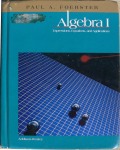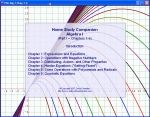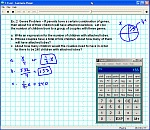Review of Foerster's Algebra 1 with a Home Study Companion − Algebra 1 by David Chandler
Some of the most popular algebra 1 programs among homeschoolers are:
- Saxon math,
- Harold Jacob's Algebra,
- Teaching Textbooks Algebra 1.
I certainly recognize each program has its followers and its good points − yet they do have their drawbacks as well.
For example, Teaching Textbooks is known for its thoroughness and being a very very comprehensive program since all solutions are provided in full on a DVD. However, people also generally consider it as very easy and not challenging.
Saxon math employs an incremental approach that introduces a new concept every day (every lesson). Many students grow bored on it, or they can't get it when new concepts come along so quickly.
Harold Jacob writes in a different, lighthearted style, with some cartoons. This book is praised a lot by homeschoolers as very interesting. People say it's good for students who have intuition with math. But did you know what Jacobs himself recommends as a followup to his algebra program? Paul Foerster's Algebra II, Trig, and Calculus.
So I want to present another alternative: start using Paul Foerster's texts at Algebra 1 level, alongside with the Home Study Companion video lessons made by David Chandler.
I feel this option, in general, is EXCELLENT, because of the quality of the text and of the video lessons. It serves best those students who don't mind – or who even want – something a little challenging and who want to gain a very strong background in mathematics.
For the rest of this review, I will now present some details from both the book and the video lessons.
Review of Algebra 1: Expressions, Equations, and Applications by Paul Foerster
 Foerster's texts are exceptional in several ways and many people keep give them high acclaim. Personally, I have to praise the algebra book as well. After seeing a competitor product (traditional algebra 1 text) that starts every lesson with a confusing real-life example, Foerster's Algebra 1 looked fantastically clear, teaching the concepts and techniques in small steps, allowing for plenty of practice. The book is very comprehensive, very logical, and often goes deeper into the topics than other algebra books.
Foerster's texts are exceptional in several ways and many people keep give them high acclaim. Personally, I have to praise the algebra book as well. After seeing a competitor product (traditional algebra 1 text) that starts every lesson with a confusing real-life example, Foerster's Algebra 1 looked fantastically clear, teaching the concepts and techniques in small steps, allowing for plenty of practice. The book is very comprehensive, very logical, and often goes deeper into the topics than other algebra books.
And it's not just that. The way concepts are presented, developed, and practiced, he has managed to weave algebra 1 topics into a connected body of knowledge. Everything new is based on previously learned concepts, and connections between the concepts are emphasized. The text just reads great.
For example, in the whole book, Foerster has a UNIFYING THEME: that of an expression. In his own words:
For increasingly complex expressions, students do these three things:
- Write an expression representing a variable quantity in some real-world situation,
- Find the value of the expression when x is known,
- Find x when the value of the expression is known.
In each lesson, after explaining a concept, the text presents several examples. Foerster wants the student to cover the answers to these examples, then try to solve the problems, and then uncover the solutions. Each lesson has plenty of practice problems (and it's not intended that students work every problem). The end of each chapter has a section of applications via numerous word problems.
His word problems are excellent. They are multi-step problems, and are not the typical knock-off problem categories (D=RT problems, work problems, mixture problems, etc.) with numbers changed. The mathematics needed to attack the problems varies from problem to problem, and the student needs to combine techniques he's learned. Foerster is teaching the student how to think analytically.
See some sample pages:
Two variables
Solve systems of equations by substitution
Ratio and proportion: example
Ratio and proportion word problems
Rational expressions
The Pythagorean Theorem practice problems
The Pythagorean Theorem word problems
Yet I have to mention this also: the examples in the lessons about word problems are written so that the many questions in the examples actually guide you step-by-step in how to think and build your equation. You will not see that in every algebra text.
Foerster doesn't forget humor, either. He has livened up the word problems with clever character names and silly puns. In general, his writing style is warm and approachable by students.
David Chandler, the author of the Homeschool Companion to Foerster's algebra 1, points out a few other good points of this text and Foerster's other books:
They have a real sense of "authorship." Most math textbooks seem to be written by a committee controlled by the publishers. Paul Foerster is an ex-engineer turned teacher who has an intimate sense of the usefulness and power of mathematics as a tool for solving real-world problems. His writing comes across like a conversation with a real author. He is also a good writer!
He has a good balance between rigor and intuition. It is more important at the introductory level to have an intuitive grasp of an issue (negative numbers, distributive law, etc.) and how to use them in a problem-solving context than to see rigorous proofs of mathematical properties. The rigor is not brushed aside: it is simply handled in a balanced way.
Some people may object to the untraditional sequence of topics, where quadratic equations are presented about in the middle of the whole text, instead of near the end.
Foerster himself mentions this in the foreword and says:
"This ... is made possible by technology, specifically, the use of calculators to evaluate radicals. As a result, students are able to work more realistic word problems in which answers are decimals."
Quadratic equations are presented in the 6th chapter of a total of 14 chapters. In chapter 6, students learn to complete the square, which is then used to prove the quadratic formula, and applications follow. Solving quadratic equations by factoring is much later, in chapter 10. This approach allows for the inclusion of quadratic equations in the problem solving sections of the second half of the book − and remember, the word problems in the various chapters are excellent!
Used and new copies are easily available at Amazon.com or other bookstores. At Amazon, you can find these editions, either used or new:
Algebra I: Expressions, Equations, and Applications (1994 edition)
Algebra 1: Expressions, Equations, and Applications (1999 edition), and
Algebra 1: Expressions, Equations, and Applications (2006 edition).
Home Study Companion − Algebra 1 by David Chandler
 Who is David Chandler? He is a mathematics teacher with BS in physics, MA in
Education, and MS in Mathematics Harvey Mudd College, Claremont Graduate University, and
California Polytechnic University). He's been teaching for 30 years in public, private, international, and charter schools at all levels from 2nd graders on up, through the full high school and junior college math and physics curriculum.
Who is David Chandler? He is a mathematics teacher with BS in physics, MA in
Education, and MS in Mathematics Harvey Mudd College, Claremont Graduate University, and
California Polytechnic University). He's been teaching for 30 years in public, private, international, and charter schools at all levels from 2nd graders on up, through the full high school and junior college math and physics curriculum.
David Chandler has put together A Home Study Companion - Algebra 1, which consists of whiteboard video lessons to accompany every lesson in Foerster's Algebra 1 book, plus a video solution guide to cover the assigned problems (usually all the even-numbered problems).
In these lessons, he usually presents the concept at hand, just like a normal teacher would do in class. He then goes through and explains in detail several examples from the corresponding lesson in Foerster's book.
In essence, you get to listen to an excellent, experienced math teacher explain the complete Algebra 1 class: the concepts and solved examples.
Below are some screenshots. Click them to enlarge.
David Chandler is not just doing example problems from the book. He is actually TEACHING you a complete lesson on the concept at hand. Based on his teaching experience, he is very conscious of the areas where students have conceptual difficulties and points out ways they can build intuition for what is going on behind the equations.
For example, Chandler explains and justifies the distributive property in more detail than the book itself. He constantly throws in little "tricks of the trade", such as which of the terms with x you should eliminate in an equation that has the unknown on both sides (for example 5x + 9 = 7x − 6), or where did the plus-minus ( ±) sign come from. Or, he takes little sidesteps to point out connections: "In fact, you've seen this before:.... ".
He also mentions the customary ways of writing mathematics. For example, while solving a certain problem from the book, he changes the variable from x to t because it is the customary variable for time. After Chapter 6, he's even added a lesson of his own (outside of Foerster's) called "Getting Fluent", which explores how you can write a solution to an equation more efficiently – the way mathematicians are accustomed to doing it.
All in all, Chandler expands the presentation of the topics and the example solutions as compared to the concise explanations in Foerster's text, adding in more detailed explanations. You'll also see exactly what buttons to push on the calculator in those problems that require such. Chandler talks and writes fairly slowly (view the sample video below) so your student should be able to keep up easily. Algebra isn't a speed contest anyway!
You could easily use these video lessons to accompany other algebra texts, as well. The example problems he uses are fully written out on the video.
Click to view a sample lesson, for Chapter 4, Section 6.
David Chandler has also developed similar home study companions with videos to accompany Foerster's other high school level books – please see the MathWithoutBorders.com website.
And besides Foerster's books, he has made a Home Study Companion for a very good geometry book called Geometry: A Guided Inquiry (the link goes to my review of it).
Algebra I: Expressions, Equations, and Applications by Paul Foerster.
Price: about $60 new; used copies vary in price from a few dollars on up. See these links that go to Amazon.com:
Algebra I: Expressions, Equations, and Applications (1994 edition)
Algebra 1: Expressions, Equations, and Applications (1999 edition), and
Algebra 1: Expressions, Equations, and Applications (2006 edition).
Home Study Companion - Algebra 1 by David Chandler. Price: $129 + sh (as of 2021)
The full solutions manual (ISBN 9780201861006) is more difficult to find (and seems to be unavailable as of 2021). However, like I mentioned, the Home Study Companion includes a solution guide on video to cover the assigned problems (usually all the even-numbered problems), so a solutions manual would be totally optional.
Review by Maria Miller
Testimonials
thank you so very much for your math program, and also for your recommendation of Math Without Borders for high school math. We found your program to be exactly what we needed at the right time. After finding CTC Math to be a bad fit for us, my kiddo wanted a workbook, and your program was wonderful. We especially liked the balance problems as an introduction to the concept of Algebra.
Mr. Chandler's Math Without Borders has also been a very good fit for us. We chose him over flashier programs because he had "real information" in his lessons (my kiddo's opinion).
I simply wanted to let you know how your program and your advice have been received by this family.
Thank you
- Sarah Kline
Receive my monthly collection of math tips & resources directly in your inbox — and get a FREE Math Mammoth book!
You can unsubscribe at any time.
Math Mammoth TourConfused about the different options? Take a virtual email tour around Math Mammoth! You'll receive: An initial email to download your GIFT of over 400 free worksheets and sample pages from my books. Six other "TOURSTOP" emails that explain the important things and commonly asked questions concerning Math Mammoth curriculum. (Find out the differences between all these different-colored series!)This way, you'll have time to digest the information over one or two weeks, plus an opportunity to ask me personally about the curriculum. A monthly collection of math teaching tips & Math Mammoth updates (unsubscribe any time) We respect your email privacy.
Note: You will FIRST get an email that asks you to confirm your email address. If you cannot find this confirmation email, please check your SPAM/JUNK folder. |
"Mini" Math Teaching CourseThis is a little "virtual" 2-week course, where you will receive emails on important topics on teaching math, including:
- How to help a student who is behind You will also receive: A GIFT of over 400 free worksheets and sample pages from my books right in the very beginning.We respect your email privacy.
Note: You will FIRST get an email that asks you to confirm your email address. If you cannot find this confirmation email, please check your SPAM/JUNK folder. |
Maria's Math TipsEnter your email to receive math teaching tips, resources, Math Mammoth news & sales, humor, and more! I tend to send out these tips about once monthly, near the beginning of the month, but occasionally you may hear from me twice per month (and sometimes less often). Peek at the previous tips here. You will also receive:
We respect your email privacy.
|
|



